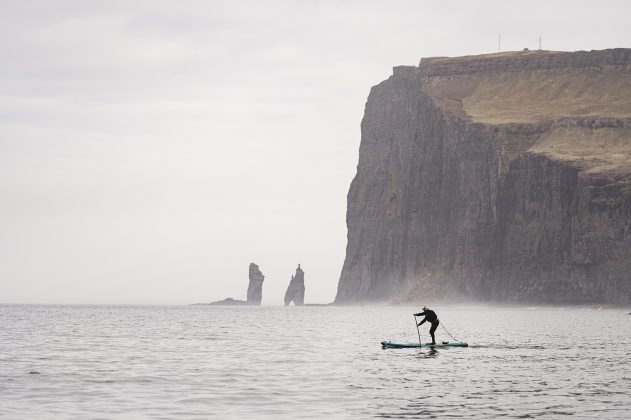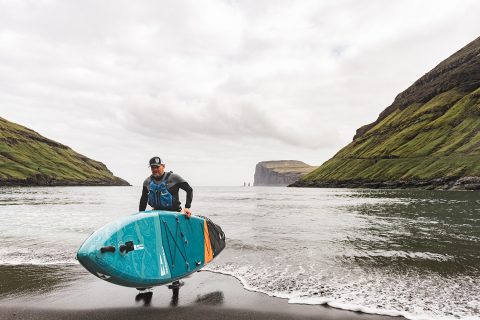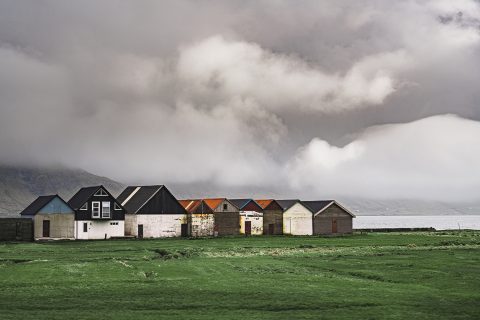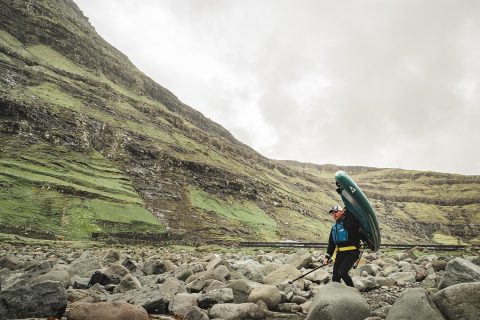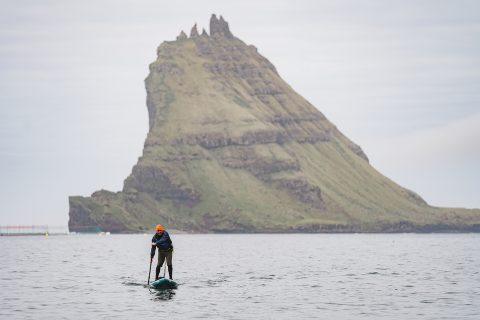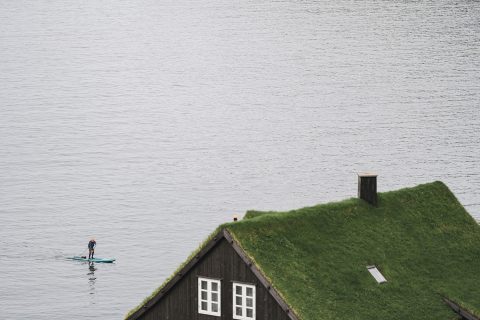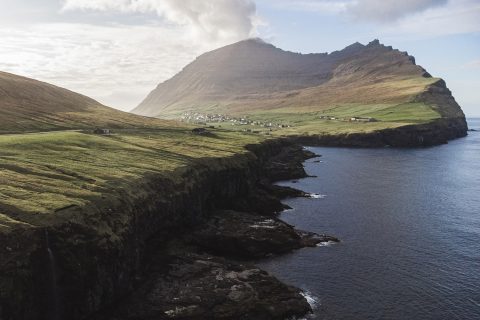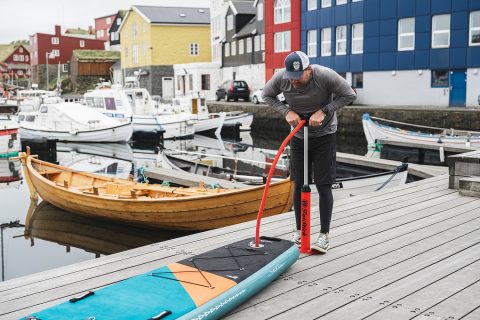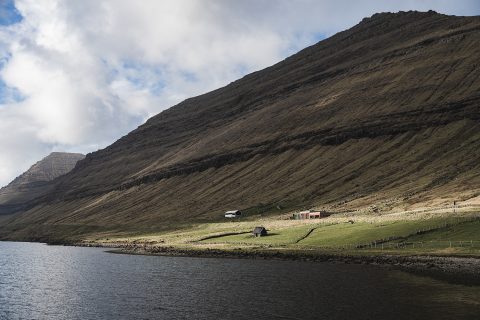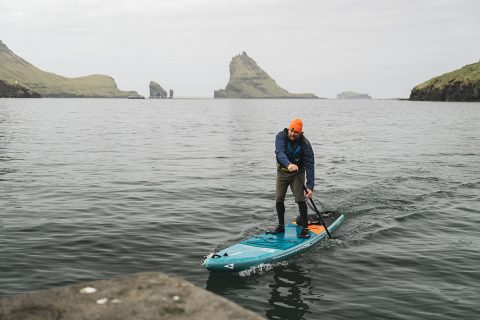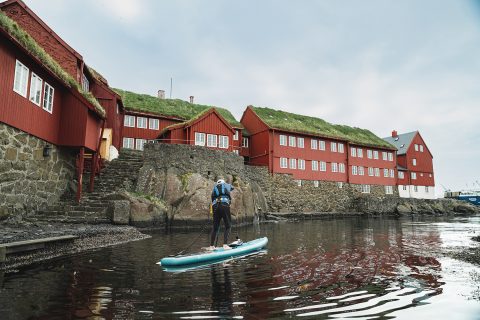BRENDON PRINCE: FAROE ISLANDS
Brendon Prince and Will Reddaway head to the Faroe Islands on an exhilarating SUP expedition to explore its majestic landscapes and to find out more about their controversial whaling traditions.
Words: Brendon Prince. // Photos: Will Reddaway.
THE MISSION
The Faroe Islands is a remote archipelago located in the North Atlantic Ocean. With its rugged cliffs (some of the highest in the world), lush green landscapes, and captivating fjords, this northern gem has become a dream destination for adventure paddlers. Will and I (Will Reddaway the awesome video photographer who created ‘Circumnavigate’- The story of The Long Paddle) embarked on an exhilarating stand-up paddle board expedition around the Faroe Islands, discovering its breath-taking beauty while finding out first hand, the complex issue of whaling, particularly the traditional practice of ‘grindadrap’.
- Brendon Prince on a mission
After three flights and a great deal of wonder about the state of our kit after three sets of baggage handlers had thrown it around. We arrived at the islands only airport, Vagar, with bags and paddles all safe – phew! The mission of our five-day visit was a short stay to navigate the pristine waters, immerse ourselves in the island’s natural wonders, and engage in a thoughtful exploration of cultural traditions and their impact on marine life. Leaving the airport and our twenty-four-hour journey behind us, we headed to the capital city of Tórshavn (a small city about the same size as a small town in UK). It was an hour’s drive from the airport and nothing prepares you for the views and tunnels you will encounter.
- Faroe Islands
FAROE ISLANDS
Faroe is made up of eighteen very large rocks that thrust through the north Atlantic Ocean, so it is easily as impressive a wonder as the Alps at the water’s edge. To acclimatise, I first paddled the capitals picturesque harbour, where colourful houses with grass roofs enclose the calm and sheltered waters. You don’t have to paddle far to encounter crazy tidal flow and swell, an average UK house would disappear quite easily between these peaks. A simple 5km paddle from harbour to the nearest island of Nolsoy could turn you into fish food only metres from the harbour if you didn’t understand flow, swell and conditions. Plus, the weather and sea state can change in seconds.
- Heading out
As you paddle away from the coastline, the untamed wild beauty of the Faroe Islands unfolds before you like a scene from Jurassic Park or Narnia. 750m majestic cliffs rise from the depths of the sea, adorned with mesmerising waterfalls that cascade into the clear waters. With each stroke of the paddle, you see another breathtaking panoramic view, with dramatic gorges and hidden caves carved by the relentless forces of the North Atlantic.
- The stunning Faroe Islands
I couldn’t paddle all the islands in just five days, but I wanted to experience the seas from each of the points of the compass and paddle the incredible tidal flow that rips through the small channels between the eighteen islands. We started by visiting the only regular surf beach of Tjornuvik. On a pan flat day, a two to three feet wave was rising from nowhere to provide a few hours of unexpected surfing. The ‘black sand’ takes a bit of getting used to as the effect on the gin clean water is a little foreboding.
- Grass roofs
HEADING NORTH
Heading North I paddled under the gigantic cliffs at Vidareidi and they didn’t disappoint – 750m straight up into the heavens! I have never paddled under such incredible vertical walls of stone. This environment belongs to the birds in the sky, and the big fish under the water, it really did feel like I was visiting a world where my stay would only be tolerated for a small amount of time. 99% of the time it’s just inconceivable to enter the water at this location, I felt blessed to experience a paddle here as I will probably never get the weather window to ever complete it again.
- Stunning scenery
This was our glorious experience for four calm, clear and sunny days. I went on to paddle on the East coast at Bour, south coast at Nolsy and on the west, paddling the currents between Hvannasuna and Svinoy. The flow, at its peak, is river fast with very few sensible ‘get outs’ – but this wilderness paddling is exactly what you want to find in the Faroe’s. Around every headland seems a lost world, or a world never seen by humans, and this is how the wildlife acts, surprised to see you!
- Pump it up
WHALING
While exploring this wild paradise, you cannot ignore the ongoing issue of whaling in the Faroe Islands, particularly the centuries-old practice of grindadrap. Grindadrap, or “the grind,” involves herding and killing pilot whales, dolphins as a means of obtaining food. This tradition, deeply rooted in Faroese culture, has been met with significant controversy and has sparked intense debates regarding animal welfare and conservation. It’s very difficult in our ‘everyone’s an expert online’ culture to get the truth behind this tradition so by visiting I wanted to find out with my own eyes and ears what’s going on.
- On a mission
As I paddle through the same waters inhabited by these magnificent creatures, conflicting emotions are felt. On one hand, the Faroese people’s strong connection to their heritage and the sea gives good understanding of their reliance on marine resources and how this has shaped their way of life. On the other hand, I grapple with the ethical concerns surrounding the practice and the impact it has on vulnerable species. These thoughts are mirrored by many Faroese people I talked to on the seventeen inhabited islands. One very interesting point made by some of the younger Faroese people was they believed the ‘Grindadrap’ would have naturally become less frequent if it wasn’t challenged by the outside world. This challenge is seen as a direct affront to the Faroe culture, heritage and freedom in their own country, perhaps giving new life to an age-old tradition.
- Faroe Islands
This is a very sensitive subject and I respect the differing perspectives. The Faroese people have historically relied on the ocean’s resources for their sustenance, and the grind is deeply intertwined with their cultural identity. However, increased awareness and evolving attitudes have prompted dialogue and the implementation of stricter regulations to ensure sustainable practices, with many initiatives and organisations working diligently to protect marine biodiversity and affect change in the Faroe Islands.
There is no easy answer and who am I to judge or pass comment having only scratched the surface of this delicate subject? Personally, I eat meat, but I wasn’t willing to eat whale. I was brought up on a farm and taught from a very early age that you should only eat what you were willing to kill yourself. I never ate whale meet on our Faroe visit because I wouldn’t be willing to kill a whale for food, but I have the benefit of writing this article from the comfort of the west country in England where there is a major supermarket less than three miles from my home. There are no major supermarkets in the Faroe Islands.
- Brendon Prince
A delicate subject, yes, but a balance must be struck between cultural traditions and conservation efforts. I feel by visiting the Faroe Islands, sharing views and dialogue will help to reach a better place for both sides and ultimately, hopefully, it will better the welfare of the most wonderful marine life on an astonishingly beautiful set of Islands… in the middle of the North Atlantic.
- Exploring
HOMEWARD BOUND
On the last day of our adventure the conditions changed in an instant, showing us who was in charge. Mother Nature rolled in the fog; I have never seen anything like it. Holding my paddle out in front of me, I could only see halfway along the shaft. I stood on the board at the shoreline and couldn’t see the bow or stern of my board. This was definitely game over and time to pack all the kit ready for a flight, a flight that was delayed ‘Due to fog!’.

